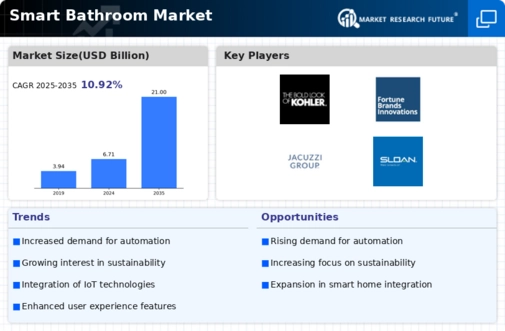Smart Bathroom Size
Smart Bathroom Market Growth Projections and Opportunities
The global Smart Bathroom market, which refers to the market for advanced bathroom fixtures and technologies, was valued at USD 5.92 billion in 2017. It is projected to reach USD 10.93 billion by 2023, with a Compound Annual Growth Rate (CAGR) of 10.74% during the forecast period. This means that the market is expected to grow steadily over the next few years.
There are several factors driving the growth of the smart bathroom market. One of the major concerns that consumers have is energy conservation and hygiene maintenance. People are becoming more conscious of saving energy and water, and they want bathroom fixtures that can help them achieve these goals. Another factor is the growing population and urbanization. As more people move to cities and live in smaller spaces, there is a greater demand for smart bathroom solutions that make the most efficient use of limited space. Additionally, the increasing aging population is driving the demand for bathroom fixtures that are accessible and easy to use for older individuals.
However, there are also some challenges that are impacting the growth of the smart bathroom market. One of these challenges is the high cost of implementation. Smart bathroom fixtures are often more expensive than traditional fixtures, which can deter some consumers from adopting these technologies. Another challenge is the dominance of traditional bathrooms. Many people are accustomed to using traditional fixtures and may be hesitant to switch to smart bathroom solutions. These factors have hindered the growth of the smart bathroom market on a global scale.
The global smart bathroom market is segmented into different categories based on product type, connectivity, end user, and region. The product types include hi-tech toilets, soaking tubs, digital faucets, and others. Among these product types, hi-tech toilets are leading the market in terms of revenue. This growth is driven by changing consumer behavior, particularly in Europe, where people are increasingly seeking luxurious bathroom experiences.
In conclusion, the global smart bathroom market is witnessing steady growth. Factors such as concerns about energy conservation and hygiene maintenance, population growth and urbanization, and the aging population are driving the demand for smart bathroom solutions. However, challenges such as the high cost of implementation and the prevalence of traditional bathrooms are hindering the market's growth. The market is segmented into different product types, with hi-tech toilets leading in terms of revenue. The growth of the smart bathroom market is also influenced by changing consumer behavior, particularly in Europe, where luxury bathroom experiences are in high demand.








Leave a Comment